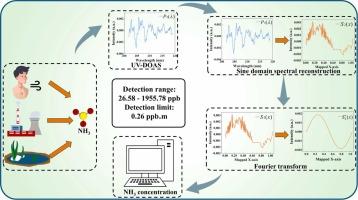Sine domain spectral transformation combined with Fourier transform: a UV-DOAS-based optical sensor-system for sub-ppb NH3 detection considering interference components
IF 3.7
1区 化学
Q1 CHEMISTRY, ANALYTICAL
引用次数: 0
Abstract
The detection of trace ammonia (NH3) concentrations in breath gas is essential for facilitating noninvasive diagnosis of kidney disease. However, broadband absorption spectra methods, including ultraviolet differential optical absorption spectroscopy (UV-DOAS), often encounter challenges related to cross-sensitivity and noise interference for trace breath NH3 detection. Here, a UV-DOAS-based sensor that combines sine domain spectral transformation and Fourier Transform (FT) is proposed to enable trace NH3 detection in complex breath environments. First, the differential absorption spectra of NH3 were obtained by UV-DOAS, and the influence of breath components on the spectra of NH3 was analyzed. Second, sine domain spectral transformation was proposed to enhance the NH3 features by mapping the absorption characteristics to the sine domain while attenuating interfering components and noise. FT is then introduced to improve the selectivity of NH3. Laboratory results demonstrate that the sensor can detect trace NH3 accurately under interfering components, with a detection range from 26.58 ppb to 1955.78 ppb. And the Allan variance analysis indicates that the minimum detection limit of the sensor is 0.26 ppb, which is among the best results in this band. In addition, a real human breath experiment was conducted, and the results indicate that the sensor can effectively detect trace NH3 in breath, demonstrating excellent reproducibility and stability. The performance of the proposed sensor demonstrates that combining sine domain spectral transformation with FT can effectively improve the detection accuracy and break the limitations of spectral overlapping, providing a novel insight for broadband spectra development.

正弦域光谱变换与傅里叶变换相结合:一种考虑干扰分量的基于uv - doas的亚ppb NH3检测光学传感器系统
呼吸气体中微量氨(NH3)浓度的检测对于促进肾脏疾病的无创诊断至关重要。然而,宽带吸收光谱方法,包括紫外差分光学吸收光谱(UV-DOAS),在检测痕量呼吸NH3时经常遇到交叉灵敏度和噪声干扰的挑战。本文提出了一种基于uv - doas的传感器,该传感器结合了正弦域光谱变换和傅立叶变换(FT),可以在复杂的呼吸环境中检测痕量NH3。首先,利用UV-DOAS获得了NH3的差分吸收光谱,并分析了呼吸成分对NH3光谱的影响。其次,提出了正弦域光谱变换,通过将吸收特性映射到正弦域来增强NH3特征,同时衰减干扰成分和噪声。然后引入傅里叶变换以提高NH3的选择性。实验结果表明,该传感器能在干扰组分下准确检测痕量NH3,检测范围为26.58 ~ 1955.78 ppb。Allan方差分析表明,该传感器的最小检测限为0.26 ppb,是该波段的最佳结果之一。此外,还进行了真实人体呼吸实验,结果表明该传感器能够有效地检测出呼吸中的痕量NH3,具有良好的再现性和稳定性。该传感器的性能表明,将正弦域频谱变换与傅里叶变换相结合可以有效提高检测精度,突破频谱重叠的限制,为宽带频谱开发提供了新的思路。
本文章由计算机程序翻译,如有差异,请以英文原文为准。
求助全文
约1分钟内获得全文
求助全文
来源期刊

Sensors and Actuators B: Chemical
工程技术-电化学
CiteScore
14.60
自引率
11.90%
发文量
1776
审稿时长
3.2 months
期刊介绍:
Sensors & Actuators, B: Chemical is an international journal focused on the research and development of chemical transducers. It covers chemical sensors and biosensors, chemical actuators, and analytical microsystems. The journal is interdisciplinary, aiming to publish original works showcasing substantial advancements beyond the current state of the art in these fields, with practical applicability to solving meaningful analytical problems. Review articles are accepted by invitation from an Editor of the journal.
 求助内容:
求助内容: 应助结果提醒方式:
应助结果提醒方式:


